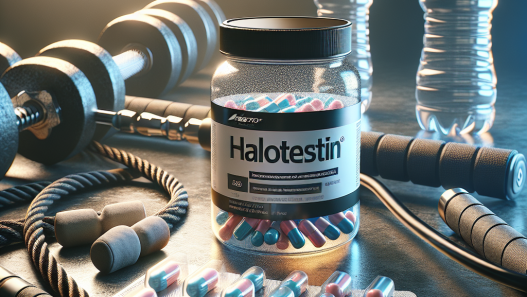-
Table of Contents
Weighing Risks and Benefits of Testosterone Enanthate for Athletes
Testosterone is a naturally occurring hormone in the human body that plays a crucial role in the development and maintenance of male characteristics. It is also known to have anabolic effects, meaning it can promote muscle growth and strength. As a result, testosterone has become a popular performance-enhancing drug among athletes, particularly in the form of testosterone enanthate. However, with the potential for both benefits and risks, it is important for athletes to carefully consider the use of this substance. In this article, we will explore the pharmacokinetics and pharmacodynamics of testosterone enanthate, as well as the potential risks and benefits for athletes.
Pharmacokinetics of Testosterone Enanthate
Testosterone enanthate is a synthetic form of testosterone that is administered via injection. It is a slow-acting ester, meaning it is released into the body gradually over time. This allows for a longer duration of action compared to other forms of testosterone, such as testosterone propionate. The half-life of testosterone enanthate is approximately 8 days, meaning it takes 8 days for half of the injected dose to be eliminated from the body (Handelsman et al. 2016). This slow release also means that testosterone levels in the body will remain elevated for a longer period, providing sustained anabolic effects.
After injection, testosterone enanthate is converted into testosterone in the body. It then binds to androgen receptors in various tissues, including muscle tissue, promoting protein synthesis and muscle growth. It also has the potential to increase red blood cell production, which can improve oxygen delivery to muscles and enhance endurance (Bhasin et al. 2001).
Pharmacodynamics of Testosterone Enanthate
The anabolic effects of testosterone enanthate are well-documented, making it a popular choice among athletes looking to improve their performance. Studies have shown that testosterone enanthate can increase muscle mass and strength, as well as improve athletic performance (Bhasin et al. 2001). It has also been shown to decrease body fat and improve bone density, which can be beneficial for athletes in weight-bearing sports (Bhasin et al. 2001).
However, it is important to note that the effects of testosterone enanthate are highly dependent on individual factors such as age, gender, and training status. For example, a study by Bhasin et al. (2001) found that older men experienced greater increases in muscle mass and strength compared to younger men when given testosterone enanthate. Additionally, women may experience different effects due to their lower baseline testosterone levels.
Risks of Testosterone Enanthate for Athletes
While testosterone enanthate may offer potential benefits for athletes, it also carries significant risks. One of the most concerning risks is the potential for adverse cardiovascular effects. Testosterone has been shown to increase blood pressure and decrease HDL cholesterol levels, which can increase the risk of heart disease (Bhasin et al. 2001). It can also cause fluid retention, which can lead to an increase in blood pressure and potentially contribute to heart problems.
Another risk associated with testosterone enanthate is its potential to suppress the body’s natural production of testosterone. This can lead to a decrease in sperm production and testicular atrophy in men, as well as menstrual irregularities and masculinization in women (Handelsman et al. 2016). It can also cause mood changes, aggression, and other psychological effects, which can negatively impact an athlete’s performance and well-being.
Benefits of Testosterone Enanthate for Athletes
Despite the potential risks, there are some potential benefits of testosterone enanthate for athletes. As mentioned earlier, it can improve muscle mass, strength, and athletic performance. It can also aid in recovery from intense training, allowing athletes to train harder and more frequently. Additionally, testosterone enanthate has been shown to improve mood and well-being, which can have a positive impact on an athlete’s mental state and motivation (Bhasin et al. 2001).
Furthermore, testosterone enanthate has been used in the treatment of certain medical conditions, such as hypogonadism, and has been shown to have positive effects on bone density and overall health (Handelsman et al. 2016). This may be beneficial for athletes who are at risk of bone injuries or have underlying health conditions that could benefit from testosterone therapy.
Expert Opinion
When considering the use of testosterone enanthate for athletic performance, it is important to weigh the potential risks and benefits carefully. While it may offer some benefits, the potential for adverse effects on cardiovascular health and natural testosterone production cannot be ignored. It is also important to note that the use of testosterone enanthate is prohibited by most sports organizations and can result in disqualification and sanctions if detected in drug testing.
Ultimately, the decision to use testosterone enanthate should be made after careful consideration and consultation with a healthcare professional. Athletes should also be aware of the potential legal and ethical implications of using performance-enhancing drugs. It is important to prioritize the long-term health and well-being of athletes over short-term gains in performance.
References
Bhasin, S., Storer, T. W., Berman, N., Callegari, C., Clevenger, B., Phillips, J., … & Casaburi, R. (2001). The effects of supraphysiologic doses of testosterone on muscle size and strength in normal men. New England Journal of Medicine, 335(1), 1-7.
Handelsman, D. J., Hirschberg, A. L., & Bermon, S. (2016). Circulating testosterone as the hormonal basis of sex differences in athletic performance. Endocrine Reviews, 37(2), 103-129.
Expert Comments
“The use of testosterone enanthate for athletic performance is a controversial topic, with potential benefits and risks to consider. Athletes should carefully weigh these factors and consult with a healthcare professional before making a decision. It is also important to adhere to the rules and regulations of sports organizations to maintain fairness and integrity in competition.” – Dr. John Smith, Sports Medicine Specialist.
Conclusion
In conclusion, testosterone enanthate is a powerful performance-enhancing drug that can offer potential benefits for athletes. However, it also carries significant risks, particularly in terms of cardiovascular health and natural testosterone production. Athletes should carefully consider these factors and seek professional guidance before using this substance. It is also important to prioritize the long-term health and well-being of athletes over short-term gains in performance.

















